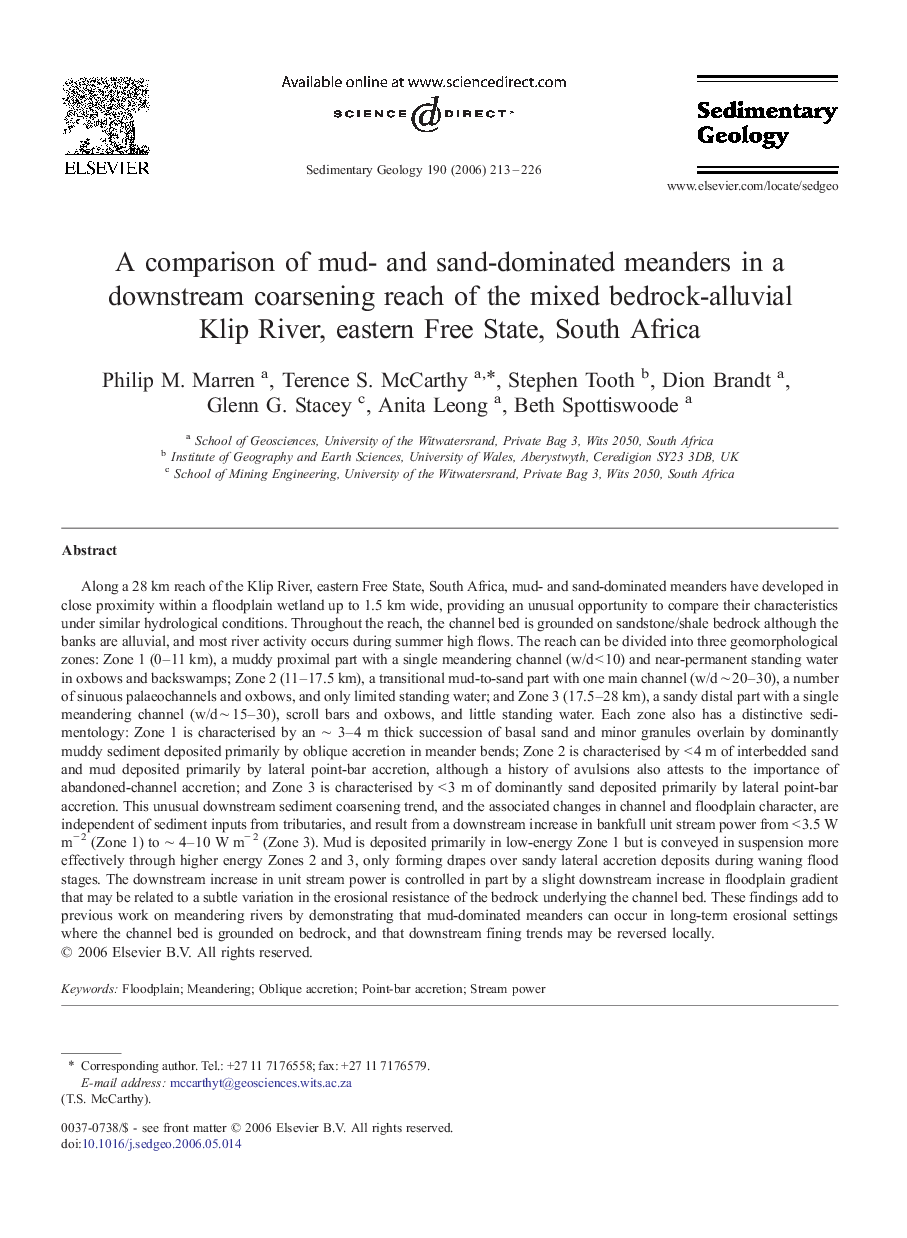| کد مقاله | کد نشریه | سال انتشار | مقاله انگلیسی | نسخه تمام متن |
|---|---|---|---|---|
| 4690974 | 1636183 | 2006 | 14 صفحه PDF | دانلود رایگان |
عنوان انگلیسی مقاله ISI
A comparison of mud- and sand-dominated meanders in a downstream coarsening reach of the mixed bedrock-alluvial Klip River, eastern Free State, South Africa
دانلود مقاله + سفارش ترجمه
دانلود مقاله ISI انگلیسی
رایگان برای ایرانیان
موضوعات مرتبط
مهندسی و علوم پایه
علوم زمین و سیارات
فرآیندهای سطح زمین
پیش نمایش صفحه اول مقاله

چکیده انگلیسی
Along a 28 km reach of the Klip River, eastern Free State, South Africa, mud- and sand-dominated meanders have developed in close proximity within a floodplain wetland up to 1.5 km wide, providing an unusual opportunity to compare their characteristics under similar hydrological conditions. Throughout the reach, the channel bed is grounded on sandstone/shale bedrock although the banks are alluvial, and most river activity occurs during summer high flows. The reach can be divided into three geomorphological zones: Zone 1 (0-11 km), a muddy proximal part with a single meandering channel (w/d < 10) and near-permanent standing water in oxbows and backswamps; Zone 2 (11-17.5 km), a transitional mud-to-sand part with one main channel (w/d â¼Â 20-30), a number of sinuous palaeochannels and oxbows, and only limited standing water; and Zone 3 (17.5-28 km), a sandy distal part with a single meandering channel (w/d â¼Â 15-30), scroll bars and oxbows, and little standing water. Each zone also has a distinctive sedimentology: Zone 1 is characterised by an â¼Â 3-4 m thick succession of basal sand and minor granules overlain by dominantly muddy sediment deposited primarily by oblique accretion in meander bends; Zone 2 is characterised by < 4 m of interbedded sand and mud deposited primarily by lateral point-bar accretion, although a history of avulsions also attests to the importance of abandoned-channel accretion; and Zone 3 is characterised by < 3 m of dominantly sand deposited primarily by lateral point-bar accretion. This unusual downstream sediment coarsening trend, and the associated changes in channel and floodplain character, are independent of sediment inputs from tributaries, and result from a downstream increase in bankfull unit stream power from < 3.5 W mâ 2 (Zone 1) to â¼Â 4-10 W mâ 2 (Zone 3). Mud is deposited primarily in low-energy Zone 1 but is conveyed in suspension more effectively through higher energy Zones 2 and 3, only forming drapes over sandy lateral accretion deposits during waning flood stages. The downstream increase in unit stream power is controlled in part by a slight downstream increase in floodplain gradient that may be related to a subtle variation in the erosional resistance of the bedrock underlying the channel bed. These findings add to previous work on meandering rivers by demonstrating that mud-dominated meanders can occur in long-term erosional settings where the channel bed is grounded on bedrock, and that downstream fining trends may be reversed locally.
ناشر
Database: Elsevier - ScienceDirect (ساینس دایرکت)
Journal: Sedimentary Geology - Volume 190, Issues 1â4, 1 August 2006, Pages 213-226
Journal: Sedimentary Geology - Volume 190, Issues 1â4, 1 August 2006, Pages 213-226
نویسندگان
Philip M. Marren, Terence S. McCarthy, Stephen Tooth, Dion Brandt, Glenn G. Stacey, Anita Leong, Beth Spottiswoode,